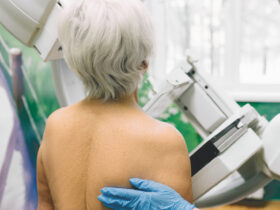By Amanda N. Sacino, MD-PhD . Neurosurgeon and Managing Partner
 If you’ve ever experienced a sharp, shooting pain that travels from your neck down into your arm, you know how debilitating it can be. This condition, often called radiating arm pain or cervical radiculopathy, typically stems from issues in the cervical spine. Between each vertebra in your spine sits a disk that acts like a cushion, absorbing shock and allowing flexibility. Over time, these disks can wear out, herniate (bulge out), or degenerate, pressing on nearby nerves. When that happens, the pain can radiate along the nerve path into your shoulder, arm, or even fingers, accompanied by numbness, tingling, or weakness.
If you’ve ever experienced a sharp, shooting pain that travels from your neck down into your arm, you know how debilitating it can be. This condition, often called radiating arm pain or cervical radiculopathy, typically stems from issues in the cervical spine. Between each vertebra in your spine sits a disk that acts like a cushion, absorbing shock and allowing flexibility. Over time, these disks can wear out, herniate (bulge out), or degenerate, pressing on nearby nerves. When that happens, the pain can radiate along the nerve path into your shoulder, arm, or even fingers, accompanied by numbness, tingling, or weakness.
For many patients, conservative treatments like physical therapy, medications, or injections provide relief. But when these aren’t enough, surgery might be recommended. One increasingly popular option is cervical disk replacement (CDR), also known as cervical arthroplasty. Unlike traditional spinal fusion, which permanently joins two vertebrae together, CDR involves removing the damaged disk and inserting an artificial one that mimics the natural disk’s function. This procedure is performed through a small incision in the front of the neck, under general anesthesia, and aims to relieve nerve pressure while maintaining mobility.
So, what makes CDR a compelling choice specifically for radiating arm pain? Let’s explore the key benefits, drawing from medical insights and patient experiences.
Effective Pain Relief
The primary goal of CDR is to decompress the pinched nerves causing your arm pain. By removing the problematic disk and replacing it with an artificial implant, surgeons can alleviate the pressure on nerve roots. Studies and patient reports show that this leads to significant improvement in radiating symptoms. For instance, many people experience a reduction in arm pain, tingling, and numbness shortly after surgery. One study found that CDR provides comparable or better relief for patients with arm pain dominant over neck pain, with lasting results.
Unlike fusion, which can sometimes leave residual discomfort due to altered biomechanics, CDR allows for more natural movement, potentially leading to complete elimination of pain. Patients often report less surgery-related discomfort post-CDR, including reduced trouble swallowing and throat irritation, thanks to its less invasive nature. Research indicates that the majority of patients see improved neck function and decreased pain levels overall. In fact, artificial disks can offer long-term relief, with some studies suggesting durability over many years.
Preservation of Natural Motion
One of the standout advantages of CDR is that it preserves your neck’s natural range of motion. In spinal fusion, the fused segment becomes rigid, which can limit how you turn your head or look up and down. This stiffness might not only feel unnatural but could also contribute to ongoing discomfort. CDR, on the other hand, uses a prosthetic disk designed to flex and rotate like your original one, allowing you to maintain everyday activities without restriction.
For those with radiating arm pain, this motion preservation is crucial because it helps avoid compensatory strain on other parts of the spine. Patients often report feeling more “normal” after recovery, with the ability to drive, work, or exercise without the limitations imposed by fusion. This freedom enhances quality of life, enabling you to engage in hobbies, sports, or simple tasks like reaching overhead without pain.
Reduced Risk of Future Problems
Another major benefit is the lower risk of adjacent segment degeneration—a common issue after fusion where nearby disks wear out faster due to increased stress. Since CDR keeps the spine moving naturally, it distributes forces more evenly, potentially preventing the need for additional surgeries down the line. This is especially appealing for younger, active patients who want a long-term solution without repeated interventions. By maintaining spinal alignment, CDR also supports better posture, reducing strain on muscles and ligaments.
Faster Recovery and Return to Life
Recovery from CDR is often quicker than from fusion. The procedure is minimally invasive, with smaller incisions and less disruption to surrounding tissues. Many patients go home the same day or after a short hospital stay, and they can resume light activities within weeks. Physical therapy focuses on gentle strengthening, and full recovery typically takes 4-6 weeks, compared to longer timelines for fusion.
Post-op instructions emphasize wound care, avoiding heavy lifting, and gradual mobility increases. This faster return to normalcy means less time off work and quicker relief from the arm pain that’s been holding you back. Patients often feel empowered to reclaim their active lifestyles sooner.
Who Might Benefit?
CDR is ideal for patients with single-level disk issues causing radiating arm pain, without severe arthritis or instability. It’s not for everyone—your surgeon will assess factors like age, overall health, and imaging results. While risks exist, such as infection or implant issues, success rates are high, with many patients enjoying pain-free lives.
In summary, cervical disk replacement offers a modern, motion-preserving alternative that effectively targets radiating arm pain by relieving nerve pressure, reducing future risks, and promoting quicker recovery. If you’re struggling with this condition, contact the spine specialists at Apex Brain & Spine for a consultation to see if cervical disk replacement is an option for you.
239-422-APEX (2739)
3530 Kraft Road, Suite 203 • Naples, FL 34105
www.apexbrainandspine.com







